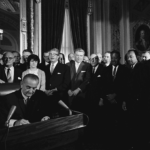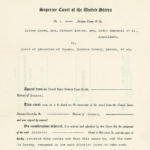When the stories of We the People become cases before the U.S. Supreme Court, and when those cases result in the opinions of the Court, history turns. The ways we think about and live under the Constitution are reflected in the Court’s interpretations in both their historical contexts and their legacies. Some cases — and the Court’s opinions in them — so profoundly alter our constitutional understandings that they can only rightly be called Landmark Cases, markers of where we have traveled as a nation. In this way, the Landmark Cases show us what we have tried, where we have been, and where we are — leaving We the People and future sessions of the Supreme Court to determine how we move forward toward a more perfect union.
Participate in the Judicial Process – Rule of Law
Review the facts, rulings, majority and minority opinions, and reasoning of these two landmark Fourteenth Amendment Supreme Court cases – Batson v. Kentucky and J.E.B. v. Alabama.
Sixth Amendment Activities
Apply landmark Supreme Court cases to contemporary scenarios related to your right to counsel and your right to a fair trial in the Sixth Amendment.
Competing Voices of the Civil Rights Movement
When most people think of the Civil Rights Movement in America, they think of Martin Luther King, Jr. delivering his “I Have a Dream” speech on the steps of the Lincoln Memorial in 1963 and receiving the Nobel Peace Prize the following year. But “the Movement” achieved its greatest results — the 1964 Civil Rights Act and the 1965 Voting Rights Act — due to the competing strategies and agendas of diverse individuals. Even black Americans, the primary beneficiaries of this landmark legislation, did not agree on the tactics that should be used to secure the equal protection of their rights. This unit presents the views of several important black leaders who shaped the debate over how to achieve freedom and equality in a nation that had long denied a portion of the American citizenry the full protection of their rights.
The Rule of Law in Your Life
Rule of law is a principle under which all persons, institutions, and entities are accountable to laws that are: publicly promulgated, equally enforced, independently adjudicated, and consistent with international human rights principles. The Administrative Office of the U.S. Courts has created this resource to help your students understand rule of law with an overview of the topic; opening discussion questions; relevant landmark case summaries; and discussion questions to check for understanding. In a Court Shorts video, nine federal judges explain how fair and consistent adherence to the law protects our rights and well-being in everyday situations.
Voting Rights Act of 1965: Lesson Plans & Resources

On August 6, 1965, President Lyndon B. Johnson signed the Voting Rights Act into law. This landmark piece of legislation made discrimination based on race illegal. This law protected the right to vote for all citizens; forced states to obey the Constitution; and reinforced the 15th Amendment. The Share My Lesson team has curated a collection of free lesson plans, activities, and classroom materials that educators can use to teach students about the Voting Rights Act.
Free Press and SCOTUS: Incorporating Case Studies in the Classroom
This lesson will ask students to engage with landmark freedom of press case studies exploring how the Supreme Court has ruled on First Amendment issues and has tried to balance competing values in our democracy.
The Supremacy Clause
Tension between the states and the federal government has been a constant throughout U.S. history. This video explores the supremacy clause in Article VI of the Constitution and key moments in the power struggle, including the landmark case McCulloch v. Maryland. In McCulloch, Chief Justice John Marshall wrote that the supremacy clause unequivocally states that the “Constitution, and the Laws of the United States … shall be the supreme Law of the Land.”
Defenders of Liberty: The People and the Press
This lesson plan is based on the Annenberg Classroom video “Freedom of the Press: New York Times v. U.S.,” which explores the First Amendment’s protection of a free press as well as the historic origins of this right and the ramifications of the landmark ruling in the Pentagon Papers case in which the Supreme Court ruled that prior restraint is unconstitutional.
Brown v. Board of Education Lesson Collection

On May 17, 1954 the Brown v. Board of Education decision was made. This landmark Supreme Court decision declared that laws establishing separate public schools for black and white children were unconstitutional. The Brown v. Board of Education ruling overturned the Plessy v. Ferguson decision of 1896, which allowed state-sponsored segregation in public schools. To support teachers as they commemorate this important anniversary in their classes, the Share My Lesson team has selected a variety of free lesson plans, educational resources and classroom materials about equity, particularly in schools.